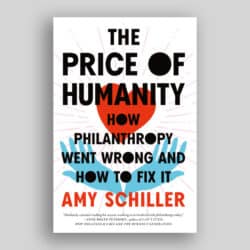by David F. Freeman, Published by Seven Locks Press, Cabin John, Maryland, U.S.A. 436 pages
REVIEWED BY ALLAN ARLETT, Executive Director, The Canadian Centre for Philanthropy.
David Freeman brought great experience to the preparation of this handbook on foundations. He began his foundation career with the Ford Foundation in 1950, moved to the Rockefeller Brothers Fund in 1958, served as the president of the Council on Foundations from 1959 to 1978 and is now executive director of the Scherman Foundation in New York.
It was under Freeman’s leadership that the Council on Foundations held its 1971
Annual Conference in Montreal. This proved to be a fortuitous decision for Canadian foundations as the invitation to attend brought more of them together than ever before. This meeting in Montreal ultimately led to the formation of The Association of Canadian Foundations.
The Handbook on Private Foundations was prepared for the Council on Foundations. The Council is a Washington-based membership organization of some 925 foundations and is celebrating its 25th Anniversary this year. Recently it has opened its membership to those involved in corporate giving. A few of Canada’s major foundations are also members of the Council.
This is a book that should be read by those seeking funds as well as those involved in granting them. Each side will gain insight into, and a better understanding of, the problems faced by the other.
Too many of those involved in seeking funds fail to understand the difficulty foundations face in determining the best projects to fund. Freeman points out that the larger U.S. foundations must decline 85% of applications they receive. Freeman is also aware of the frustrations felt by grant seekers. He urges foundation executives to be good listeners. “Remember that most applicants believe deeply in the particular activity for which they are seeking support. Whether you agree with their priorities or not, respect their motivation, and be a good listener. Humility is not a trait frequently associated with giving away money. It should be.”
At the outset of his book, Freeman indicates why he thinks foundations are important: “Their influence within the voluntary sector is not dependent on the dollar value of their grants, which is small in comparison to government spending. Rather, it lies in their flexibility in responding to needs, their willingness to take risks, and in the pluralistic nature of foundation decision making.”
Freeman has solid advice to give about the amount of money needed to justify this “institutionalized approach” to philanthropy. He suggests that “unless the foundation can be expected to generate an annual ‘payout’ of at least $25,000 from endowment income, annual donations to it, or a combination of the two, it is probably not worthwhile to incur the expense of organization and administration. If endowment income is to be the sole source of grant funds, a minimum endowment of $500,000 is thus indicated, assuming a conservative return on investment of five per cent.”
Freeman makes an important exception to this rule in cases where a substantial endowment is anticipated from the estate of the donor. “Then the small foundation, created during the donor’s lifetime serves as a useful device for exploring different areas of philanthropy, interesting, and training younger members of a family in the business of giving money away, and developing a responsible board in whom the donor has confidence.”
For those with the necessary resources who are serious about philanthropy the foundation is an admirable instrument. As Freeman states, “To give away money wisely is never easy but an institutionalized approach provides more opportunity for careful decision making, and insulation from friendly arm twisting and telethon-type emotional appeals to which individual and corporate givers are inevitably exposed.”
Freeman does not hesitate to point out the responsibilities falling on those involved with “private foundations,” a term he finds unfortunate “because the word ‘private’ tends to blur an essential fact: that foundations are committed to public purposes, even though their assets are derived from private sources.”
He also notes the view held by a number of foundations that “… the money in the foundation is ‘ours’ and that it is not anyone else’s business how the money is invested or spent. This attitude has led to much of the hostility foundations have encountered, both in the media and in Congress. It is out of date and wrong: assets transferred to a foundation are irrevocably dedicated to charitable purposes, and cannot be taken back by the donor.”
Freeman also reviews the process of establishing a charitable f.oundation, establishing a board, determining the areas of interest of a foundation, deciding when staff should be hired, respecting and encouraging grant requests, (i.e., not taking a merely passive role), different categories of grant support and the grantmaking process, types of grants, selection and role of the board.
Freeman and the Council have wisely recognised that a handbook can be used to pull together· valuable material from a wide variety of other sources. The handbook has 20 appendices totalling 303 pages and includes a declination policy and sample letters of declination. Having this material within arm’s reach in a single publication is itself worth the price of the book.
While Canadians will have less interest in the explanation of I.R.S. regulations, recent developments indicate tax officials in Canada are studying U.S. practices more closely to see if they might be applied to the Canadian situation.
To sum up, The Handbook On Private Foundations fills an important gap in the field; it should be compulsory reading for all those interested in philanthropy.
Bookshelf
The First Ten Years
by Earl F. Damude, Editor Emeritus, The Medical Post Published by The Physicians’ Services Incorporated Foundation, Toronto 1980, 139 pp.
REVIEWED BY LYNN BEYAN, Editor, The Philanthropist, and Member, The Ontario Bar
This book is appropriately subtitled “The Story of the beginning and achievements of The Physicians’ Services Incorporated Foundation during the first decade from 1970 to 1980”.
The book is divided into three parts. The first, just over 50 pages in length, gives a brief history of Physicians’ Services Incorporated (P.S.I.), the transition to the government-operated medical plan, and the establishment and operation of the P.S.I. Foundation, funded by the reserves of P.S.I.
The description of the Foundation’s operations is divided into: investments, grantmaking, and organization and management. A detailed review of the Foundation’s investment policy and results for its first decade is provided, with credit for these results being given both to the decision to maintain a diversified investment portfolio and the decision to employ professional managers.
The scope of the philanthropic activities of the Foundation is described as encompassing: health education, health-care delivery and health research in the Province of Ontario. Extensive examples are provided of granting programs and changes made to the original granting policy based on such factors as experience and increased income.
The section on organization and management describes the composition and selection of the membership and the structure of the Foundation. Reference is made to the cost of operations, with a suggestion that detailed information may be obtained from annual reports of the Foundation. Finally, the contribution of the Foundation and its executive director, Arthur Bond, to the establishment of The Association of Canadian Foundations, is described.
The second part of the book is a summary of 12 selected research projects funded by the Foundation. The third part contains seven appendices including a complete list of all grants awarded by the Foundation.
The author has enthusiastically reviewed the accomplishments of the Foundation and written a concise, easily-read history of one of Canada’s more successful foundations.


